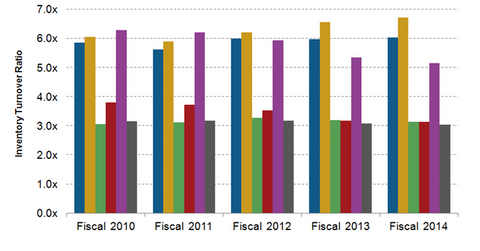A Look at Ross Stores’ Superior Inventory Management Skills
Ross Stores’ inventory management system is supported by its strong supplier relationships and the strategic location of its buying offices.
Nov. 6 2015, Updated 9:04 a.m. ET

Strong inventory management
Ross Stores (ROST) has a tight control on its inventory, which allows it to increase the percentage of its receipt of fresh merchandise for customers, thus boosting sales. Also, faster inventory turnover helps the company to maximize its merchandise margin.
According to Ross Stores, the company has reduced its in-store inventories by over 40% over the past several years.
Impressive metrics
Ross Stores’ inventory turnover ratio is better than those of department store peers Dillard’s (DDS), Kohl’s (KSS), Nordstrom (JWN), and Macy’s (M). In fiscal 2014, Ross Stores had an inventory turnover ratio of 6.0x.
Leading off-price retailer TJX Companies, which has a very efficient internally developed inventory management system, reported an inventory turnover ratio of 6.7x in the comparable fiscal year. The inventory turnover ratios of Dillard’s, Kohl’s, Nordstrom, and Macy’s came in at 3.1x, 3.1x, 5.2x, and 3.0x, respectively, in fiscal 2014.
Ross Stores is better than its department store peers when it comes to another key metric, days inventory outstanding, which indicates the average number of days a company holds its inventory.
In fiscal 2014, Ross Stores reported days inventory outstanding of 60.3. This compares to inventory days outstanding of 115.9, 115.7, 70.9, and 119.5 for Dillard’s, Kohl’s, Nordstrom, and Macy’s, respectively. TJX Companies’ days inventory outstanding of 54.2x was better than Ross Stores’ in the comparable fiscal year.
The First Trust Consumer Discretionary AlphaDEX ETF (FXD) has 0.8% exposure to Ross Stores.
Packaway inventory
In Part Two of this series, we mentioned that Ross Stores is able to offer discounted prices to customers as it purchases manufacturer overruns and canceled orders both during and at the end of a season. Such inventory is called “packaway” inventory and is stored in warehouses until a later date.
The timing of the release of packaway inventory to the company’s stores depends on the product mix and seasonality of the merchandise, as well as the company’s merchandise assortment plans. Typically, packaway inventory remains in storage for less than six months. Packaway inventory accounted for ~45% of the company’s inventory in fiscal 2014.
Ross Stores’ inventory management system is supported by its strong supplier relationships and the strategic location of its buying offices. The company’s primary buying offices are located in New York City and Los Angeles, two key apparel markets. These locations allow the company’s buyers to take advantage of sourcing opportunities and negotiate purchases with vendors and manufacturers.
Lean inventory levels also help in improving margins. We’ll discuss the company’s margins in the next part of this series.
